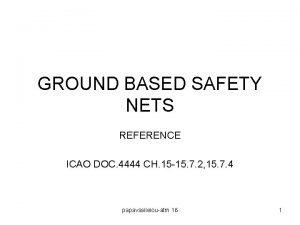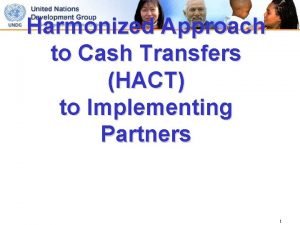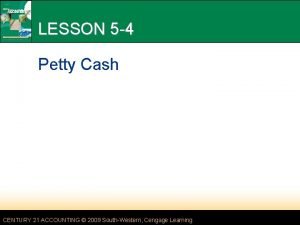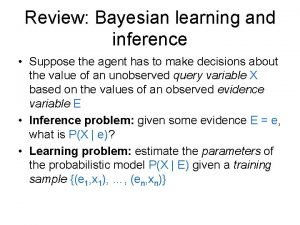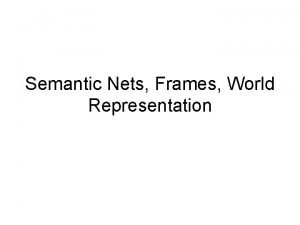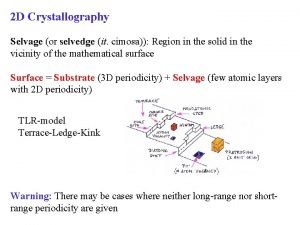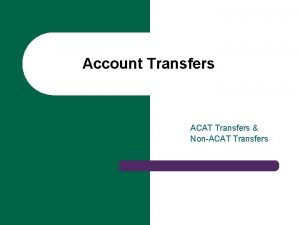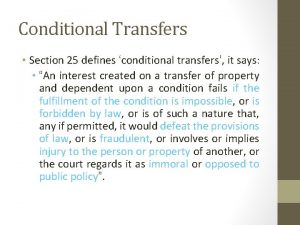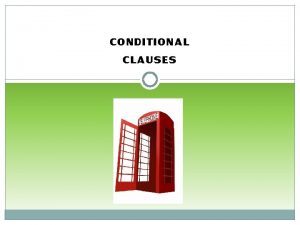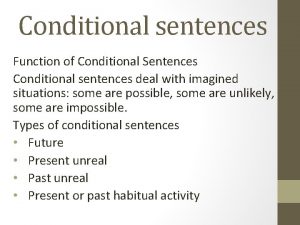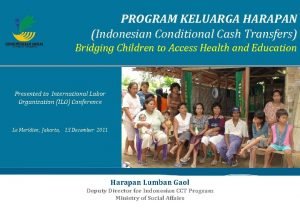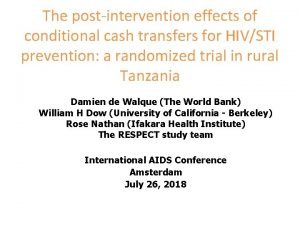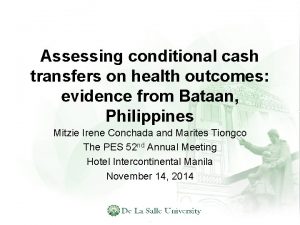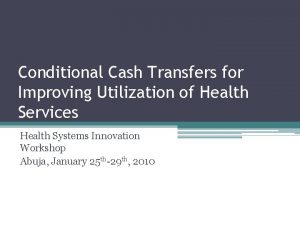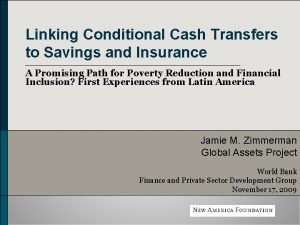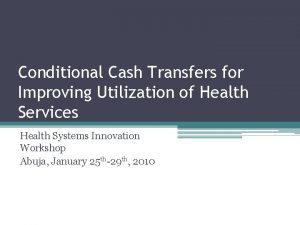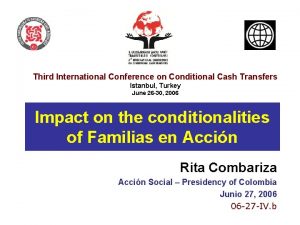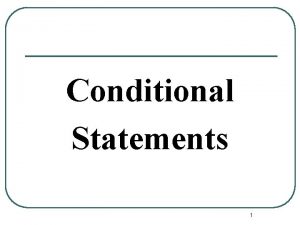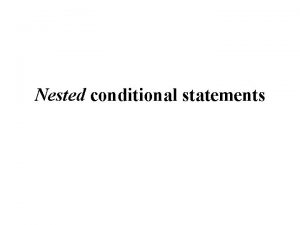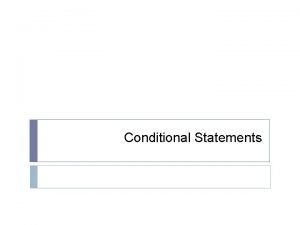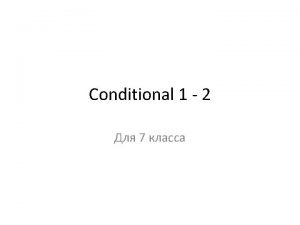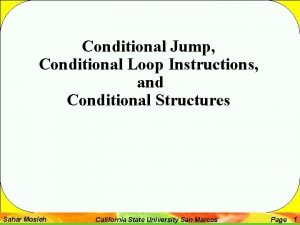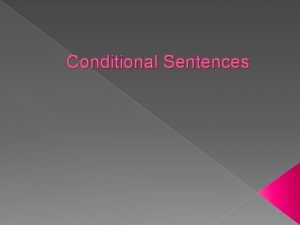Do Conditional Cash Transfers Function as Safety Nets



























- Slides: 27

Do Conditional Cash Transfers Function as Safety Nets? Evidence from Malawi. Sarah Baird (George Washington University) Craig Mc. Intosh (UC San Diego) Berk Özler (World Bank)

Background and Motivation The conventional argument for CCTs as safety net programs: n Regular cash transfer payments allow households to smooth shocks, save for future. n Decreasing relative price of schooling may further prevent households from using withdrawal of kids (particularly girls? ) from school as a buffering tool. However: n If the incentives provided by a CCT are strong enough to keep kids in school even in the face of shocks, well and good. n If not, then conditioning the transfers on school attendance will the permission social from protection Not undermine for citation without explicit the authors. dimension of CCTs, expose households to the further 2

Background and Motivation Why may dropout expose girls to additional risks in SSA? n There is a knife-edge relationship between leaving school and marriage & pregnancy in much of SSA. n Teenage girls typically have HIV rates that match men 10 years older, much higher than their male age-mates. n Economic pressure may play a direct role in driving sexual risk debut and other risk factors. n On the face of it, it appears that ‘Conditional Cash Transfer’ programs, giving money in return for regular school attendance, might have an effect on marriage, pregnancy, and HIV in this context as well as simply on schooling. Not for citation without explicit permission from the authors. 3

Background and Motivation n Conditional Cash Transfers (CCTs) are “… targeted to the poor and made conditional on certain behaviors of recipient households. ” n As of 2007, 29 countries around the world had some type of a Conditional Cash Transfer program (CCT) in place, with many others planning or piloting one (World Bank, 2009) n Unconditional Cash Transfer programs (UCT) are also common and have also been shown to change behaviors on which CCTs are typically conditioned. Not for citation without explicit permission from the authors. 4

Background and Motivation n n Whether the conditions are necessary has recently become a bigger debate. Proponents of CCTs point to market failures, which are addressed by the condition. q n Evidence (a few slides from now) suggests that the effects of UCTs are (or would be) small to non-existent. The Zomba Cash Transfer Program q q q Zomba, Malawi: adolescent girls aged 13 -22 who were never married as of baseline. One arm received CCTs, another arm receives the exact same transfers, but unconditionally (UCT). Provides an experimental estimate of the impact of the conditionality itself Not for citation without explicit permission from the authors. 5

The research questions of SIHR: n Do the conditions themselves matter in CCT programs, or would households have made the same choices anyway? q n Do the behaviors that we care about respond to transfer size? q n Split of transfers randomized between guardian and beneficiary. Do the programs have a meaning effect on STDs and HIV? q n Transfer amounts were randomized between $5 & $15 per month. Does it matter whether transfers go to households or girls? q n To answer this, two randomized arms, one CCT, other UCT. Conduct biomarker testing for HIV, HSV-2, and syphilis. Not for citation without explicit permission from the Are impacts on beneficiaries just ‘diverting’ to nonauthors. 6

Zomba Cash Transfer Research Design Not for citation without explicit permission from the authors. 7

Zomba District & Town Not for citation without explicit permission from the authors. 8

Evidence on the relative effectiveness of CCTs vs. UCTs n Evidence points us heavily in favor of CCTs. q q n de Brauw and Hoddinot (2008); Schady and Araujo (2008) – using implementation glitches Bourguignon, Ferreira, Leite (2003); Todd and Wolpin (2006) – using structural models. Two common themes to these papers: q q All from Latin America (Brazil, Ecuador, and Mexico) All with very little ‘income’ effect. Not for citation without explicit permission from the authors. 9

Zomba Cash Transfer Program Implementation n For CCT recipients, attendance is checked monthly at each program school using a combination of physical checks and phone calls (with random spot checks in Year 1, i. e. 2008). n For CCT recipients, the payment for the next month is withheld if attendance is below the required threshold. However, the girl remains in the program. n UCT recipients receive their transfers by only showing up. Not for citation without explicit permission from the authors. 10

Making the initial offers, Fall 2007. Not for citation without explicit permission from the authors. 11

Program impacts on schooling: Enrollment Not for citation without explicit permission from the authors. 12

Program impacts on schooling: Test Scores Not for citation without explicit permission from the authors. 13

Program impacts on marriage and pregnancy Not for citation without explicit permission from the authors. 14

How do we reconcile the differential program impacts on schooling vs. marriage & pregnancy? n To help think about this issue, we can categorize the target population into three latent strata: 1. 2. 3. q q q UCT compliers: Remain in school under a UCT. CCT compliers: Remain in school under a CCT but not under a UCT. Non-compliers: Drop out of school even under a CCT. UCT compliers will likely be similar under CCT and UCT. CCT compliers have a schooling impact under a CCT only. Non-compliers have an income impact under a UCT only. Not for citation without explicit permission from the authors. 15

Marriage and Enrollment at Follow-up Not for citation without explicit permission from the authors. 16

Impacts on partner age: Not for citation without explicit permission from the authors. 17

Shock & Program impacts on Expenditures: Not for citation without explicit permission from the authors. 18

Program doesn’t change incidence of shocks: Not for citation without explicit permission from the authors. 19

Program doesn’t change response to shocks: Not for citation without explicit permission from the authors. 20

Social Protection from Mom only: Program helps insulate girls against shocks, but only in female-headed households! Not for citation without explicit permission from the authors. 21

Concluding Discussion n n n Cash transfer programs have strong effects on consumption. Do not appear to change the incidence of or response to shocks. Social Protection role of UCT appears superior in the sense that the CCT is cutting household off just at the moment that the girls are most vulnerable. Social Protection role of the CCT in preventing shocks from adversely effecting girls is found only in femaleheaded households. Clear evidence that adolescent girls in Malawi expose themselves to STD & HIV risk because of economic factors; they cease to do this when provided with income support. Not for citation explicit permission from thesplits. Very little sensitivity towithout transfer amounts, 22 authors.

Thank you Not for citation without explicit permission from the authors.

Offer Letters Conditional Transfers n The Zomba Cash Transfer Program (ZCTP) with funding from the World Bank would like to offer you, _[NAME]_____, a cash transfer to help you and your family with the burdens of school attendance for the 2009 school year. By accepting this offer, in return for going to school you will be given: Unconditional transfers n These monthly transfer amounts You are receiving this money in order specified above are given to you as a to help you return to school or stay in result of a lottery. You are not required school. In order to receive this money to do anything more to receive this you MUST attend school at least 80% money. You will receive this money for of the days for which your school is 10 months between February and Not for citation without explicit permission from the in session. 24 authors. November, 2009. n n The Zomba Cash Transfer Program (ZCTP), with funding from the World Bank, would like to offer you, __[NAME]____, a cash transfer to help you and your family. By accepting this offer you will be given:

1. The rules of the program were well understood by the girls in the UCT arm: Not for citation without explicit permission from the authors. 25

2. Girls in the UCT arm knew about the CCT arm: n n Int: Earlier you talked of conditional and unconditional. What did you say about the rules for conditional girls? Res: They had to attend class all the time…not missing more than 3 days of classes in a week – like I already explained. Int: How did you say the program managers knew about the missed school days? Res: They would go to the schools…For example, I have a friend, Jane [not real name], who was learning at Samama. They would go each month to the school to monitor her attendance, and if she was absent for more than three days she would not get her monthly money. Not for citation without explicit permission from the authors. 26

Summary of the conditions under which the UCT experiment took place: 1. UCT beneficiaries fully understood their treatment status and were never worried about not receiving their payments due to school attendance. 2. However, the UCT experiment did not happen in a vacuum. It took place in a district where a CCT program was simultaneously running in neighboring communities. Hence, the UCT for citation without explicit permission from the experiment. Nottook place under a rubric of authors. 27
 Icao 4444
Icao 4444 Safety nets must be drop tested
Safety nets must be drop tested Part six recording bank and petty cash transactions answers
Part six recording bank and petty cash transactions answers Hact assessment
Hact assessment Cash to cash cycle time
Cash to cash cycle time Cash to cash cycle time
Cash to cash cycle time Cash in cash out example
Cash in cash out example The cash budget shows anticipated cash flows
The cash budget shows anticipated cash flows Paid cash to replenish the petty cash fund
Paid cash to replenish the petty cash fund Bayes nets
Bayes nets Represent solid figures using nets
Represent solid figures using nets Partitioned semantic nets in artificial intelligence
Partitioned semantic nets in artificial intelligence Surface area using nets
Surface area using nets 1-1 practice nets and drawings for visualizing geometry
1-1 practice nets and drawings for visualizing geometry Petri nets properties analysis and applications
Petri nets properties analysis and applications Net triangular prism
Net triangular prism Nets church planting
Nets church planting List the 4 nets for better internet searching
List the 4 nets for better internet searching 1-1 nets and drawings for visualizing geometry
1-1 nets and drawings for visualizing geometry Semantic nets and frames
Semantic nets and frames Nets and drawings for visualizing geometry
Nets and drawings for visualizing geometry Cylinder net
Cylinder net Nets blox
Nets blox Bravais nets
Bravais nets Semantic nets
Semantic nets Apple sweatshop
Apple sweatshop For better convenience
For better convenience Gabriel y petri
Gabriel y petri
